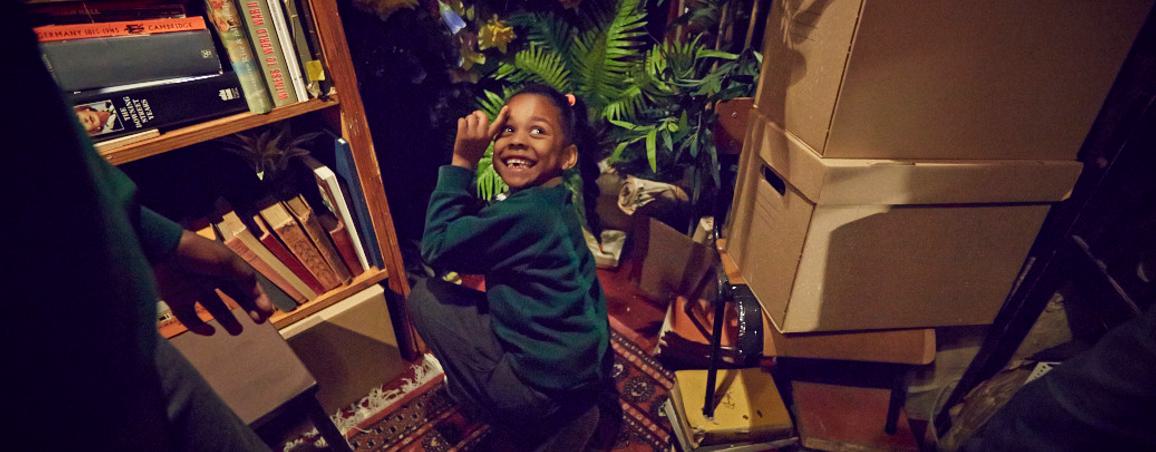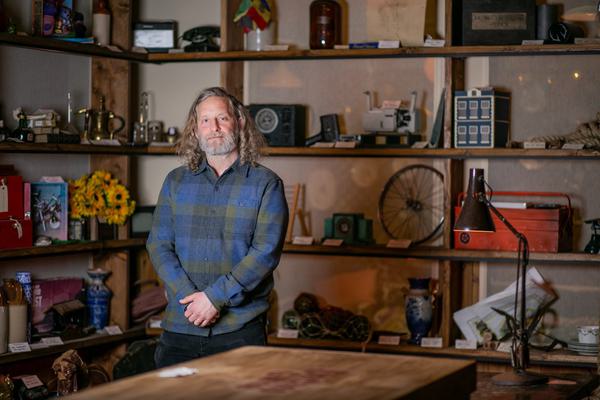Sparking a Joy for Literacy with Immersive Education
Posted January 22nd 2024News Story

In The Lost Lending Library, children meet Peabody, a guardian of the library. Sat amidst towers of books and memorabilia from around the world, Peabody explains to them that the library travels from place to place, drawn by pockets of imagination as it searches for more stories and new ‘apprentices’ to write them. This may be the first time children are introduced to valuing their imagination as a skill. It’s something intrinsic to our projects: the fuel for the immersive element of our work, allowing us to suspend reality for an hour or two. It’s here that children are motivated to generate stories towards a shared end goal, and in the process, improve their literacy skills through necessity: an unexpected situation demands that they communicate their ideas as clearly as possible.
Immersive learning puts children in the driving seat, channelling the literacy skills they already have towards a narrative they are in charge of shaping. It also encourages children to value their literacy skills with fresh eyes: when faced with imaginary dilemmas or situations to solve, their ability to read, write, listen and speak are the precise tools they need to work their way through to a resolution.
In this blog, we’ll look at how three of our projects harness children’s imagination, and how this has been shown to improve enthusiasm for literacy in the classroom.
Improving clarity of ideas and communication in early years with The Wishing Cupboard
A small, mysterious cabinet appears inside an Early Years Foundation Stage classroom, containing a selection of objects. Children learn that they must use their imaginations for the objects to find their true purpose. Children are tasked with creating wishes for their objects, in which they’ll need to be as clear as possible in their ideas. Teachers then create mini-installations for each object, based on requests from children.
Dr Angela Colvert, Deputy Director for Innovation at University of Sheffield and research fellow at the University of Roehampton has been studying how children responded to The Wishing Cupboard, as part of our research on the Immersive Learning Collective. Her interim findings suggested that seeing their ideas manifest as mini-installations was key to children’s engagement:
“There was a sense that in both children’s verbal and written representations of wishes, they began to add more detail in order to better communicate their ideas to the cupboard. One teacher noted improvements in spoken language as well as in children’s desire to apply their understanding of letter sounds when writing words.”
As another teacher described to Colvert:
“Once we’d seen a few scenes come to life they WANTED their scenes to come to life, they wanted to be involved in it … overall in the whole class, their drawing has become much more detailed. Most people could pick it up and tell what they were trying to draw whereas before obviously because it’s a nursery, it was more mark making.”
At this Early Years stage, it is rewarding to see how young children are motivated to improve their clarity of ideas through speech or drawings, using their imagination to create wishes for the lost objects.
Incorporating storytelling skills to find a resolution with A Small Tale
In A Small Tale, a teacher and their class read a mysterious old picture book about two mischievous and messy tiny people with a love of stories. But when they return to the book the following day the pages are all blank, except for two sets of tiny footprints. The characters have escaped! Will the pupils be able to get them back to safety, before it’s too late? The class discovers that these tiny people love adventure stories, and if they can write their own, they may be able to tempt the small adventurers back to the safety of their picture book…
A Small Tale aims to inspire children to read and write, raising the standards of their reading, speaking and listening skills in the process. Learners are central to the story, as they control what happens next, and have to incorporate their learning to reach a resolution.
As one Scottish educator who took part in A Small Tale, reported: “I have a number of pupils who find writing challenging. Their imagination was captured and I have had some of the most wonderful, detailed writing from them since. They have in the past found writing any more than a paragraph a challenge.”
By giving their story writing a context and a clear goal, students are able to flex their literacy skills with a highly focused task.
Rewarding imaginative flair with The Lost Lending Library
Let’s venture over to The Lost Lending Library, where we last left Peabody introducing their work as a guardian for this mysterious travelling library. Soon after, Peabody receives word that the Library wants the children to input a new story into its collection. Depending on the age of learners, the children are given the task of either creating one together or each writing their own for the Library.
By incorporating theatrical elements into this experience, it becomes highly engaging for pupils, who are then asked to use their own imaginations to extend the narrative.
“I remember Peabody and the library being cosy and dark. There was a train chugging along the wall and there were lots of postcards from all over the world. Afterwards I wrote a story about the Moon,” says Ivy, a Lost Lending Library participant excitedly recalling her experience.
“Undoubtedly, literacy is the most important skill children learn at school, and too often learners are sadly put off because reading and writing is not always accessible to them or they find it too difficult, or lack motivation. ‘The Lost Lending Library’ is the most brilliantly creative way to promote literacy and to get the children excited about books. I can’t wait to see more stories Ivy creates, and I’m sure that she’ll remember this experience for a long time to come,” said Danja, Ivy’s mother.
By enlisting the children in an immersive story with a fantastical setting, learners are given a reason to engage their wildest imaginations, connecting this to writing with a clear purpose and outcome. What’s more, by incorporating it in an other-wordly library setting, pupils get to experience what many people love about getting lost in books and the different worlds that unfold at the turn of a page.
“I feel full of stories – I think I can be a storymaker, I think I can make up poems.” – Year 4 participant of The Lost Lending Library, Kingsmead Primary School, 2013
Immersive learning capitalises on literacy the skills children already have, giving learners a task to put these to the test. By placing children at the centre of the story, where their imaginations have a purpose, it’s possible to spark a joy for literacy across all ages and abilities.
Explore how immersive projects can create long-lasting enthusiasm for literacy in your own classroom with A Small Tale, a teacher-led adventure and literacy project for Key Stage 1 children, led by the teacher in the classroom. Or, find out more about The Wishing Cupboard, our project for Early Years Foundation Stage.
Discover our research connecting immersive learning with improved literacy skills in our resources section.


